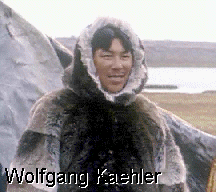
| |
 |
![]()
This comes from the book Our Boots, an Inuit Women's Art by Jill Oakes and Rick Riewe.
Eider, murre, and other bird skins were used for stockings and over slippers when caribou skins were unavailable. ... Silatik Meeko provided a detailed description of the techniques employed by women on the Belcher Islands.
Hunters bring back the eiders whole for the women to process. After the birds are allowed to partially thaw so the skin can be easily loosened from the meat, the wings and legs are taken off. The skin is sliced around the bill, another cut is made about halfway down the neck, and the head is pulled through this last incision. According to Meeko (1989):
I hold the bill in my mouth, grasp the skin at both sides of the neck, and peel the skin down towards the tail. The skin ends up being inside out. After removing excess blood and fat from the skin, I turn it right side out and rub it in snow until the feathers are clean.
The long neck skins are tied together in groups of two, hung over a line outside, and allowed to freeze-dry overnight. Then the skins are turned with the flesh side to the outside to dry for about a day. When the skins are partially dry, the loose surface fat is chewed and pulled off, and the fat embedded in the skin is removed by an action similar to sucking on a baby bottle. Meeko also said that:
Beginners quickly learn not to suck too hard, as you can pull the feathers right through the skin into your throat, but if you suck too gently, the skin becomes moist. It takes about two hours to prepare one skin until it feels dry. My throat becomes red and sore after sucking off fat for several hours, until I get used to it. I often gain weight from swallowing some of the fat while preparing bird skins.
 Like I said, you may have to make a few adaptations, but it may be an
alternative to subsisting on bugs!
Like I said, you may have to make a few adaptations, but it may be an
alternative to subsisting on bugs!
Grant Goltz
[email protected]
Native American Technologies
P. O. Box 121
Longville, MN 56655